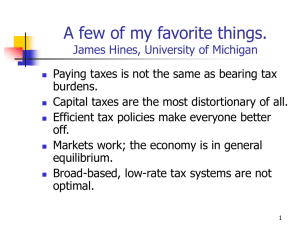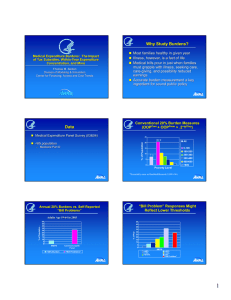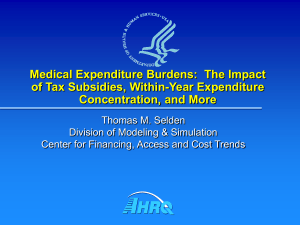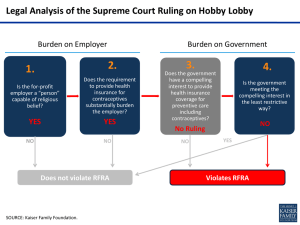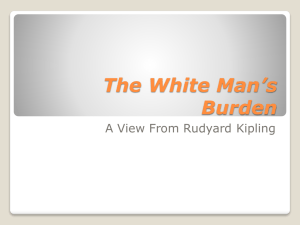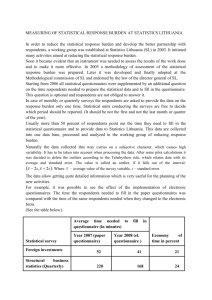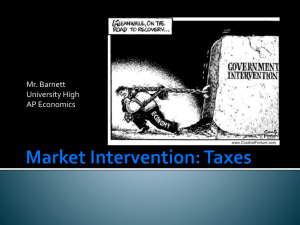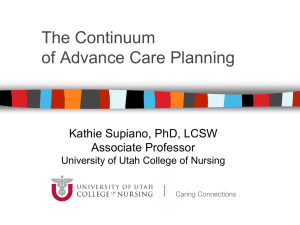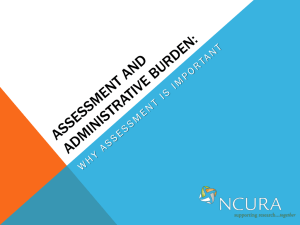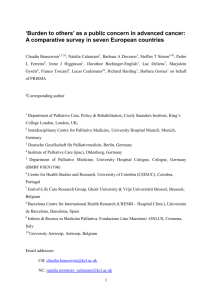DOC - Europa
advertisement
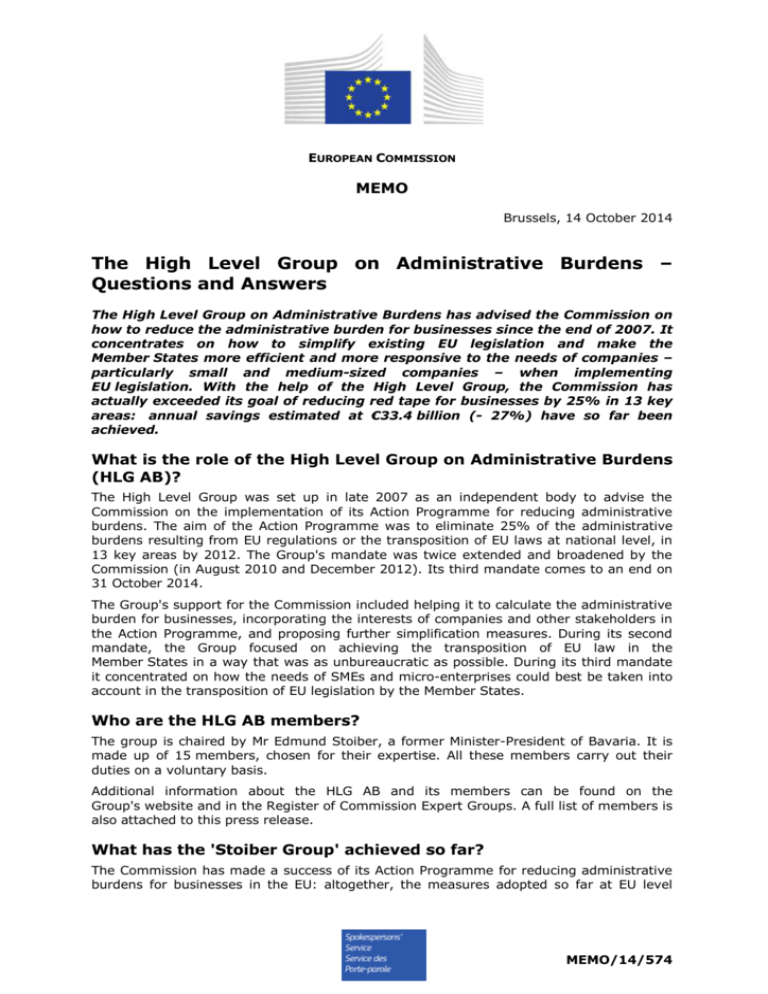
EUROPEAN COMMISSION
MEMO
Brussels, 14 October 2014
The High Level Group on Administrative Burdens –
Questions and Answers
The High Level Group on Administrative Burdens has advised the Commission on
how to reduce the administrative burden for businesses since the end of 2007. It
concentrates on how to simplify existing EU legislation and make the
Member States more efficient and more responsive to the needs of companies –
particularly small and medium-sized companies – when implementing
EU legislation. With the help of the High Level Group, the Commission has
actually exceeded its goal of reducing red tape for businesses by 25% in 13 key
areas: annual savings estimated at €33.4 billion (- 27%) have so far been
achieved.
What is the role of the High Level Group on Administrative Burdens
(HLG AB)?
The High Level Group was set up in late 2007 as an independent body to advise the
Commission on the implementation of its Action Programme for reducing administrative
burdens. The aim of the Action Programme was to eliminate 25% of the administrative
burdens resulting from EU regulations or the transposition of EU laws at national level, in
13 key areas by 2012. The Group's mandate was twice extended and broadened by the
Commission (in August 2010 and December 2012). Its third mandate comes to an end on
31 October 2014.
The Group's support for the Commission included helping it to calculate the administrative
burden for businesses, incorporating the interests of companies and other stakeholders in
the Action Programme, and proposing further simplification measures. During its second
mandate, the Group focused on achieving the transposition of EU law in the
Member States in a way that was as unbureaucratic as possible. During its third mandate
it concentrated on how the needs of SMEs and micro-enterprises could best be taken into
account in the transposition of EU legislation by the Member States.
Who are the HLG AB members?
The group is chaired by Mr Edmund Stoiber, a former Minister-President of Bavaria. It is
made up of 15 members, chosen for their expertise. All these members carry out their
duties on a voluntary basis.
Additional information about the HLG AB and its members can be found on the
Group's website and in the Register of Commission Expert Groups. A full list of members is
also attached to this press release.
What has the 'Stoiber Group' achieved so far?
The Commission has made a success of its Action Programme for reducing administrative
burdens for businesses in the EU: altogether, the measures adopted so far at EU level
MEMO/14/574
have enabled businesses to make estimated annual savings in the region of
€33.4 billion, which represents an easing of the burden by 27%. The Commission
has therefore exceeded its ambitious savings target of 25%, set in the
Action Programme.
Edmund Stoiber and the members of the Group were of great help to the Commission in
this respect. In particular, the Group supported the Commission in its successful
negotiations with the Council and Parliament on the two most important
Commission proposals on the reduction of red tape, namely VAT e-invoicing, which could
save businesses up to €18 billion, and a proposal to exempt micro-enterprises from
accounting rules, which could result in €6.3 billion in savings. The Commission has in
addition also taken up and implemented many more of the Group's ideas for further
administrative burden reduction measures.
The Group has held 54 meetings, at which it adopted over 45 opinions and reports.
The subjects covered by the opinions have included administrative burden reduction
measures in all 13 priority areas of the Action Programme (such as tax law, accounts,
statistics, transport, and public procurement). They originate with several hundred
suggestions by the Commission's departments, individual enterprises or business
associations, national, regional and local governments or individual citizens. The Group
met President Barroso and many of the Commissioners on a number of occasions and was
in regular contact with the Commission's departments.
The most significant event of the second mandate was the 'Europe can do better'
report (IP/12/146), which set out best practice in the Member States on implementing
EU legislation in the least burdensome way.
During its third mandate, the Group conducted case studies on selected examples of
the transposition into national law of eight simplification measures from the
Action Programme, as the benefits of EU measures for easing the administrative burden
are only felt by those they are intended to help if they are transposed successfully into
national law.
On 14 October 2014 the Group published its final report and presented it to Commission
President José Manuel Barroso. In addition to the Group's conclusions from its work over
its three mandates, the report also contains wide-ranging recommendations for future
improvements for reducing bureaucracy.
All relevant documents on the Group's activities, such as agendas and minutes of
meetings, presentations, reports and opinions, including dissenting opinions, are published
on
the
HLG
AB's
website
(http://ec.europa.eu/smartregulation/refit/admin_burden/high_level_group_en.htm).
What conclusions
'Stoiber Group'?
can
be
drawn
from
the
work
of
the
The Commission's 2007 Action Programme was able to exceed its goal of reducing the
administrative burden by 25% at EU level. Now it is up to the Member States to ensure
that businesses actually feel the benefits, by transposing the burden reduction
measures into national law in the most effective and unbureaucratic way
possible and by applying them rigorously: studies carried out in connection with the
Action Programme1 have shown that 32% of administrative costs are due not to the
1
COM(2009) 544 - Action Programme for Reducing Administrative Burdens in the EU,
Sectoral Reduction Plans and 2009 Actions, p. 6.
2
demands of EU law itself, but to its being transposed in the Member States in a way
that is inefficient or that goes beyond the requirements of EU law ('gold-plating').
To this end, the exchange of experiences between the Member States regarding the
national transposition of EU laws must be significantly improved.
The Group's report shows that implementation of the Action Programme has led to
substantial progress in many areas, although the Member States were not always able
to put a figure on it. This progress was apparent in, among other things, the simplification
of the accounting principles for SMEs, acceptance of e-invoices for value added tax, and
intra-Community trade statistics. More savings can be made if the Member States
continue to implement the reduction measures consistently. In doing so they should make
good use of all the simplification options provided for by the relevant EU law.
What recommendations does the Stoiber Group's final report make
for future improvements in reducing bureaucracy?
The independent group's final report contains a number of recommendations for improving
legislation and cutting red tape addressed both to the EU Institutions and to the
Member States. These recommendations include the setting of a firm target for
administrative-burden savings, the creation of an independent body of experts to review
impact assessments on the administrative costs of Commission legislative proposals,
concentration of the Commission's work on the most important questions that have to be
resolved at EU level and on the needs of small and medium-sized undertakings, and more
rapid and better information on European legislation.
All these recommendations can be consulted in the Group's final report. A dissenting
minority conclusion is also attached to the final report.
The final report has been published in several languages on the High Level Group's
website.
Further information
Visit the High Level Group's website (which includes the final report):
http://ec.europa.eu/smart-regulation/refit/admin_burden/high_level_group_en.htm
Visit the Commission's website on smart regulation:
http://ec.europa.eu/smart-regulation/index_en.htm
Visit the Commission's website on administrative burden reduction:
http://ec.europa.eu/smart-regulation/refit/admin_burden/index_en.htm
MEMO/13/786: 'Commission initiatives to cut red-tape and reduce regulatory burden –
Questions and Answers'
3
Annex: High Level Group on Administrative Burdens – List of
Members
Members
Professional Background
Chair of the High Level Group
1
STOIBER Edmund (DE)
2
ALMGREN Gunilla (SE)
President of the European Association of Craft,
Small and Medium-Sized Enterprises (UEAPME)
3
BERGER Roland (DE)
Honorary Chairman of the Board of Roland Berger
Strategy Consultants
4
CARVALHO GOUCHA
Gabriel Côrte-Real de
(PT)
Member of the Portuguese Parliament, General Counsel
of the Mirpuri Investments Group, Vice President for
Institutional and International Relations of PME Portugal
(an association of SMEs)
5
CASADO NAVARRORUBIO Jesús (ES)
Secretary-General of European Family Businesses
6
GIBBONS Michael (UK)
Chairman of the Regulatory Policy Committee in the UK
7
KOSINSKA Monika
(PL/UK)
Secretary-General of the European Public Health
Alliance
8
LEITÃO MARQUES Maria
Manuel (PT)
Full Professor of the School of Economics at the
University of Coimbra; former Secretary of State for
Administrative Modernisation
9
LUDEWIG Johannes (DE)
Chairman of the German National Regulatory Control
Council
10
MURRAY Jim (IE)
Former Director of the European Consumer
Organisation (BEUC)
11
PESONEN Pekka (FI)
Secretary-General of the umbrella organisations COPA
(European Farmers) and COGECA (European AgriCooperatives)
Former Minister-President of Bavaria
4
12
RENSHAW Nina (UK)
Green 10; Deputy Director Transport & Environment;
Executive of ECOS (European Environmental Citizens'
Organisation for Standardisation)
13
RØNNE MØLLER Heidi
(DK)
EU Adviser of the Danish Confederation of Trade Unions
14
STARCZEWSKAKRZYSZTOSZEK
Małgorzata (PL)
Head of Department of Research and Economic
Analyses
of
the
Polish
Confederation
of
Private Employers (Lewiatan); Member of the Economic
Council at the Chancellery of the Prime Minister of
Poland
15
TEN HOOPEN Jan (NL)
Chair of ACTAL - the Dutch Advisory Board on
Regulatory Burden
5
